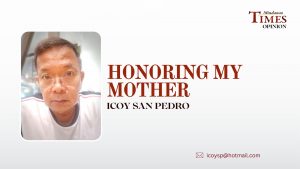By 8 o’clock this morning, or even earlier, most of the country’s provinces and cities were already back humming in economic activities, though still on a limited basis. This after the government declared a down-grading of the categories of quarantine from enhanced community quarantine (ECQ) to that of modified ECQ, to general community quarantine (GCQ), to modified GCQ except for Metro Manila and a few other areas that are still considered at the “high risk” level for the continued prevalence of the deadly Corona Virus Disease 2019 (CoViD 19).
It may be like a New Year celebration for Filipinos residing in places where the quarantine categories are relaxed. At least they now have a semblance of freedom to pursue their livelihood endeavors since the lucky ones are already allowed to work in industries and businesses authorized by the government to operate.
But then, again, our country’s health authorities working in close coordination with the World Health Organization (WHO) still believe that unless and until a vaccine against CoViD 19 is discovered and administered, hurrying our return to the prior-to-the-pandemic normalcy makes us highly vulnerable to a more massive infection of the deadly virus.
Hence, we are still under strict advice to follow the health protocols imposed by the government under the quarantine regime.
In other words, according to the Inter-Agency Task Force (IATF) on the CoViD 19 response the down-grading does not mean lifting of the many restrictions pertinent to the protection of the people’s health.
That is why, according to the guidelines to be followed under the new quarantine categories, hygiene practices such as frequent hand-washing, wearing of face mask, social distancing, staying at home for non-working family members shall remain imposed.
The government will not also do away with some restrictions in the people’s freedom of movement by maintaining checkpoints in strategic locations in the various provinces, cities, municipalities and barangays. This, according to the IATF, will ensure that persons who are potential carriers of the virus not yet identified because of their not having undergone testing procedures, cannot transmit the disease to more people in more places.
Checkpoints, according to Department of the Interior and Local Governments (DILG) Secretary Eduardo Ano, will also prevent the convergence of people in areas where they used to crowd during the old normal times.
That is why the IATF has not recommended the opening of both indoor and outdoor entertainment facilities. The task force has even ordered mall management to reduce the level of air-conditioning temperature in specific sections of the establishment.
The IATF believes that by controlling the small temperature people will not be enticed to go inside just to “cool” themselves.
By maintaining the restrictions, the country’s journey to a “new normal” is still tortuous and requires sacrifices. There will probably be more than fifty percent of Filipinos who will continue to be jobless and extremely hard-up in feeding their families. What with industries and businesses allowed to operate under the present quarantine categories ordered to have only about fifty percent of their work force back in harness?
Lucky for those who are considered indispensable manpower to production and operation; they’d surely be the first to be called back by their employers. So, the rest will have to pray even harder so their time for resumption of work would come earlier.
But again, recommending this return-to-work methodology is one strategy that could control the convergence of people in limited spaces like the workplace. Thus, the scheme is very much in accord with the government’s response protocols.
And perhaps, the most affected sector of the continuance of the restrictions especially the gathering of huge number of people is the religious. Under the guidelines set in the down-graded quarantine categories, holding of religious activities like daily and weekly masses for the Catholics is still strictly prohibited.
We have no doubt that the restriction in holding masses or services could be a major frustration on the religious sector. It could also be down-heartening to the faithful and believers who have made religion and observance of its many practices a major part of their lives.
For who will not endure such frustration when shortly before the deadline of the extended ECQ imposition last May 15, the Catholic Bishops Conference of the Philippines (CBCP), and possibly the leaders of other religious sects in the country, were already laying down their own protocols to ensure that their resumption of activities will be in accord with government guidelines. Unfortunately for the various religious groups, their holding of church activities is still put on hold.
We know the religious sector had been in the forefront of activities opposing certain government policies even up to the time of the country’s immediate past. Will the denial of the Church request for it to resume religious activities goad its leaders into defiance? If they do, will they be willing to take on the consequences should a major recurrence of the CoViD 19 happen with religious gatherings identified to be the source of the new massive virus infection?
This, we believe, will put Church leaders into serious discernment of whatever moves they may take in regards to the non-inclusion of religious activities with mass people participation as among those allowed to resume under the down-graded quarantine categories.


